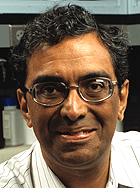Himadri B. Pakrasi, Ph.D., has been named the George William and Irene Koechig Freiberg Professor of Biology in Arts & Sciences. An installation will occur during the 2007-08 academic year, according to Edward S. Macias, Ph.D., executive vice chancellor, dean of Arts & Sciences and the Barbara and David Thomas Distinguished Professor in Arts & Sciences, who made the announcement.

“Some of my happiest moments as dean are recognizing and rewarding outstanding faculty members’ achievements,” Macias said. “Himadri Pakrasi’s achievements in biology are outstanding, and he has been very successful at building bridges to several fields beyond biology and beyond Arts & Sciences.”
Pakrasi’s keen interest in bridging the differences between the biological and physical sciences is reflected by his recent appointment as professor of energy in the School of Engineering & Applied Science.
Pakrasi also is in the Division of Biology and Biomedical Sciences and has a special interest in guiding biochemistry and plant biology doctoral students. His teaching activities have focused on biochemistry and microbiology.
Pakrasi’s research involves systems biology, photosynthesis, membrane biology, metal homeostasis, redox processes and genomics.
Several funding agencies have recognized Pakrasi’s work. He leads a Membrane Biology Grand Challenge project to explore scientific enigmas in microbiology.
The project — a partnership between the University and the W.R. Wiley Environmental Molecular Sciences Laboratory at the Pacific Northwest National Laboratory of the Department of Energy (DOE) — involves the biology of membrane proteins in cyanobacteria, important photosynthetic microorganisms found in the world’s oceans. Pakrasi is the first scientist from a university chosen by the DOE to lead an initiative in a national laboratory.
In 2004, the Frontiers in Integrative Biological Research program at the National Science Foundation awarded a $5 million, five-year grant titled “A Systems Approach to Study Redox Regulation of Functions of Photosynthetic Organisms.” Pakrasi is the project’s principal investigator.
Pakrasi’s international recognition includes serving as an Alexander von Humboldt Fellow at Munich University in Germany, a Distinguished Fellow at the Biosciences Institute of Nagoya University in Japan and a Lady Davis Visiting Professor at Hebrew University in Jerusalem.
He is a fellow of the American Association for the Advancement of Science and a member of the American Society for Biochemistry and Molecular Biology, the American Society of Plant Biologists and the American Society for Microbiology. He is on the editorial board of the Journal of Biological Chemistry.
Pakrasi has served on various departmental and University-wide committees. Chancellor Mark S. Wrighton appointed him to the McDonnell International Scholars Academy as ambassador-at-large. Pakrasi will help foster partnerships between the University and other renowned research institutions, particularly those in India. He directs the University’s effort to develop groundbreaking initiatives in bioenergy. He has organized and participated in several academic conferences across disciplines and served on various review panels. His publications are extensive.
Pakrasi joined Washington University in 1987 as assistant professor; he was promoted to associate professor in 1993 and to professor in 1997.
Pakrasi earned a doctorate in biology from the University of Missouri-Columbia in 1984. He earned a master’s in physics from the University of Calcutta in 1976 and a master’s in biophysics from the University of Rochester in 1980. He earned a bachelor’s degree in physics from Presidency College in Calcutta in 1973.
The George William and Irene Koechig Freiberg Professor of Biology was established in 1984 to honor a faculty member distinguished in the field of biology who has demonstrated leadership in research and teaching.
Irene Koechig taught chemistry and microbiology at Washington University’s School of Nursing from 1920 through the mid-1950s and was an instructor in biological chemistry at the School of Medicine from 1928 through the mid-1940s. She authored several scientific articles, as well as the textbook Chemistry for Nurses.